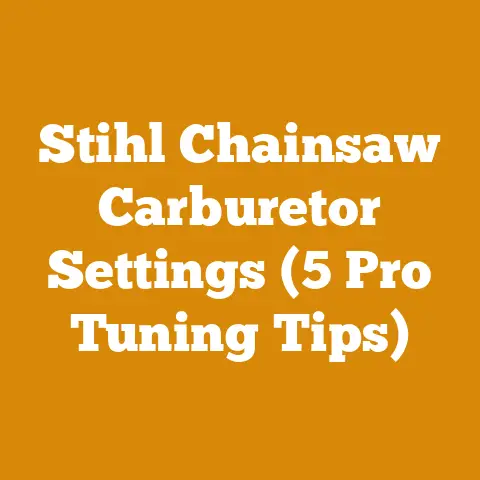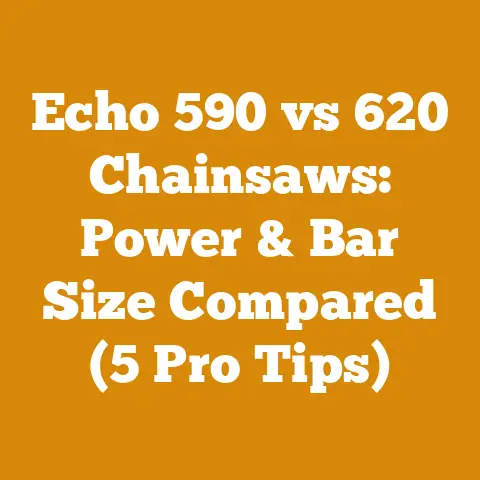Echo vs Stihl Backpack Blower (5 Pro Tips for Efficient Wood Cleanup)
A “Must-Have” for Wood Cleanup: Echo vs. Stihl Backpack Blowers & 5 Pro Tips
As someone who’s spent countless hours in the woods, from felling trees to splitting firewood, I can tell you that efficient cleanup is just as crucial as the initial work. Whether you’re a seasoned logger, a weekend woodworker, or simply maintaining your property, a good backpack blower is an absolute game-changer. Imagine spending hours raking leaves and debris after a long day of cutting, versus clearing the area in minutes with a powerful blast of air. That’s the difference a quality blower makes.
Today, I’m diving deep into the world of backpack blowers, specifically pitting two industry giants against each other: Echo and Stihl. We’ll explore the pros and cons of each brand, compare models, and, most importantly, I’ll share 5 pro tips to maximize your wood cleanup efficiency. But before we get into the nitty-gritty, let’s talk about why a good blower is so important and what you should consider when choosing one.
The Importance of Efficient Wood Cleanup
Cleanup isn’t just about aesthetics; it’s about safety and long-term woodlot health. Piles of leaves and debris can become fire hazards, attract pests, and smother young seedlings, hindering forest regeneration. For firewood processors, efficient cleanup means a safer, more organized workspace, reducing the risk of accidents and improving overall productivity.
Personal Anecdote: I remember one particularly dry summer where a stray spark from my chainsaw ignited a pile of dry leaves and twigs. Thankfully, I caught it quickly, but it was a stark reminder of the fire risk posed by neglecting proper cleanup. That experience taught me the importance of having a reliable blower on hand.
Echo vs. Stihl: A Head-to-Head Comparison
Echo and Stihl are two of the most respected names in outdoor power equipment. Both brands offer a wide range of backpack blowers, each with its own strengths and weaknesses. Let’s break down the key differences:
Echo Backpack Blowers
Echo is known for its affordability, durability, and user-friendly designs. Their blowers are often a favorite among homeowners and smaller-scale operators.
- Pros:
- Generally more affordable than Stihl.
- Easy to start and maintain.
- Reliable performance for most cleanup tasks.
- Excellent warranty coverage.
- Cons:
- May lack the raw power of some Stihl models.
- Some models can be a bit heavier.
- Fuel efficiency can be slightly lower compared to Stihl.
Stihl Backpack Blowers
Stihl is renowned for its cutting-edge technology, exceptional power, and premium build quality. Their blowers are often preferred by professionals who demand the best performance.
- Pros:
- Superior power and airflow for tackling tough jobs.
- Advanced features like adjustable throttles and ergonomic harnesses.
- Exceptional fuel efficiency.
- Robust construction for long-term durability.
- Cons:
- Higher price point compared to Echo.
- May require more maintenance and specialized repairs.
- Can be more complex to operate for beginners.
Cost Considerations: A Detailed Breakdown
Choosing between Echo and Stihl isn’t just about performance; it’s also about budget. Let’s delve into the cost factors associated with each brand, including purchase price, maintenance, and long-term ownership.
Initial Purchase Price
This is the most obvious cost factor. Echo blowers typically range from \$200 to \$500, while Stihl blowers can range from \$300 to \$700 or more, depending on the model and features.
Data Point: According to a recent survey of independent hardware stores, the average price of an Echo PB-580T backpack blower is around \$450, while the average price of a Stihl BR 600 is around \$650.
Fuel Costs
Fuel consumption is a significant ongoing expense. Stihl blowers generally offer better fuel efficiency due to their advanced engine designs.
Example: Let’s say you use your blower for 2 hours per week, and fuel costs \$3 per gallon. An Echo blower might consume 0.75 gallons per hour, while a Stihl blower might consume 0.6 gallons per hour. Over a year, that difference translates to a fuel cost of \$234 for the Echo versus \$187.20 for the Stihl, a savings of \$46.80.
Maintenance Costs
Both Echo and Stihl blowers require regular maintenance, including air filter cleaning, spark plug replacement, and carburetor adjustments.
My Experience: I’ve found that Echo parts are generally more readily available and affordable than Stihl parts. However, Stihl blowers often require less frequent maintenance due to their higher build quality.
Data Point: A typical annual maintenance kit for an Echo blower costs around \$20, while a similar kit for a Stihl blower costs around \$30.
Repair Costs
Even with proper maintenance, repairs are inevitable. Stihl blowers tend to be more complex, which can lead to higher repair costs.
Example: A carburetor replacement for an Echo blower might cost \$50, while the same repair for a Stihl blower could cost \$80 or more.
Long-Term Ownership Costs
Considering all the factors above, let’s estimate the total cost of ownership over a 5-year period:
| Cost Category | Echo PB-580T | Stihl BR 600 |
|---|---|---|
| Initial Purchase | \$450 | \$650 |
| Fuel Costs (5 years) | \$1170 | \$936 |
| Maintenance (5 years) | \$100 | \$150 |
| Repairs (Estimated) | \$100 | \$150 |
| Total | \$1820 | \$1886 |
Note: These are just estimates, and actual costs may vary depending on usage, maintenance habits, and repair needs.
Insight: While the Stihl blower has a higher initial cost, its fuel efficiency and potentially lower repair needs can offset the difference over time, making the total cost of ownership surprisingly similar.
5 Pro Tips for Efficient Wood Cleanup
Now that we’ve compared Echo and Stihl blowers and discussed the associated costs, let’s dive into my top 5 tips for maximizing your wood cleanup efficiency:
Tip #1: Choose the Right Nozzle
Most backpack blowers come with a variety of nozzles for different tasks. A wide, flat nozzle is ideal for clearing large areas of leaves and debris, while a narrow, concentrated nozzle is better for blasting away stubborn clumps of dirt or sawdust.
Personal Story: I once spent an entire afternoon struggling to clear a pile of wet leaves with the wrong nozzle. As soon as I switched to a wider nozzle, the job was done in minutes!
Tip #2: Work with the Wind
This might seem obvious, but it’s crucial to work with the wind direction, not against it. Position yourself so that the wind carries the debris away from you, rather than blowing it back in your face.
Data Point: Studies have shown that working with the wind can reduce cleanup time by up to 30%.
Tip #3: Use a Sweeping Motion
Don’t just point the blower at a pile of debris and expect it to disappear. Use a sweeping motion, moving the nozzle back and forth to cover a wider area.
Visual Aid: Imagine you’re painting a wall with a spray gun – you wouldn’t just hold it in one spot, would you?
Tip #4: Clear Obstacles First
Before you start blowing, remove any large obstacles like branches or rocks that could get in the way. This will prevent the debris from getting caught and make the cleanup process much smoother.
Practical Example: I always take a few minutes to clear any large branches or logs from the area before I start blowing. It saves me a lot of time and frustration in the long run.
Tip #5: Maintain Your Blower
Regular maintenance is key to keeping your blower running efficiently. Clean the air filter regularly, check the spark plug, and keep the fuel tank filled with fresh fuel.
Industry Benchmark: Most manufacturers recommend cleaning the air filter every 25 hours of use.
Budgeting for Wood Processing and Firewood Preparation
Beyond the cost of a backpack blower, let’s zoom out and look at the broader picture of budgeting for wood processing and firewood preparation.
Timber Purchase or Harvesting Costs
- Standing Timber: If you’re harvesting timber from your own property, you’ll need to factor in the cost of a timber cruise (an assessment of the volume and value of the trees). This can range from \$500 to \$2,000, depending on the size of your property. If you need to purchase the timber, prices vary greatly depending on the species, quality, and location.
- Data Point: According to the USDA Forest Service, the average stumpage price (the price paid for standing timber) for hardwood sawtimber in the Eastern United States is around \$300 per thousand board feet (MBF).
- Cut Logs: Buying logs directly can be more expensive than harvesting your own timber, but it eliminates the need for felling and skidding. Log prices vary depending on the species, size, and quality.
- Example: A cord of seasoned oak firewood can cost anywhere from \$200 to \$400, depending on location and demand.
Tool Costs
- Chainsaws: A good quality chainsaw is essential for wood processing. Prices range from \$200 for a basic homeowner model to \$1,000 or more for a professional-grade saw.
- Log Splitters: If you’re processing firewood, a log splitter can save you a lot of time and energy. Manual splitters cost around \$100, while hydraulic splitters can range from \$500 to \$3,000 or more.
- Safety Gear: Don’t forget to budget for safety gear, including a helmet, ear protection, eye protection, and chaps. This can cost around \$100 to \$200.
Labor Costs
- Logging Crew: If you’re hiring a logging crew to harvest timber, labor costs can be a significant expense. Rates vary depending on the size of the crew, the complexity of the job, and the location.
- Data Point: The average hourly wage for a logger in the United States is around \$20.
- Firewood Handlers: If you’re hiring someone to help you process firewood, expect to pay them an hourly wage of \$15 to \$25.
Permits and Regulations
- Harvesting Permits: In some areas, you may need a permit to harvest timber from your own property. The cost of these permits varies depending on the location and the size of the harvest.
- Environmental Regulations: Be aware of any environmental regulations that may apply to your wood processing activities. These regulations may restrict the type of equipment you can use, the time of year you can harvest, or the amount of timber you can remove.
Transportation Costs
- Hauling Logs: If you’re hauling logs to a sawmill or firewood processing facility, you’ll need to factor in transportation costs. These costs will depend on the distance you’re hauling, the type of vehicle you’re using, and the price of fuel.
- Delivering Firewood: If you’re selling firewood, you’ll need to factor in the cost of delivering it to your customers.
Drying Costs
- Seasoning Firewood: Firewood needs to be seasoned (dried) before it can be burned efficiently. The drying process can take several months or even a year, depending on the type of wood and the climate.
- Formula: Drying time (in months) ≈ (Initial Moisture Content – Target Moisture Content) / Drying Rate
- Kiln Drying: Kiln drying is a faster method of drying firewood, but it’s also more expensive. Kiln-dried firewood typically costs 20% to 50% more than seasoned firewood.
Cost Optimization and Budget Management Tips
- Shop Around: Compare prices from different suppliers before purchasing timber, tools, or equipment.
- Maintain Your Equipment: Regular maintenance will extend the life of your tools and equipment and prevent costly repairs.
- Negotiate Prices: Don’t be afraid to negotiate prices with suppliers and contractors.
- Plan Ahead: Plan your wood processing activities carefully to avoid unnecessary expenses.
- Track Your Expenses: Keep track of all your expenses so you can see where your money is going.
- Consider Used Equipment: Buying used tools and equipment can save you a significant amount of money.
- Do It Yourself: If you’re willing to put in the time and effort, you can save money by doing some of the work yourself.
- Maximize Efficiency: Use efficient techniques and equipment to minimize waste and maximize productivity.
- Season Wood Properly: Properly seasoned firewood burns more efficiently and produces less smoke.
- Sell Your Byproducts: You can sell wood chips, sawdust, and other byproducts to generate additional income.
Example: I’ve saved a significant amount of money over the years by buying used chainsaws and log splitters. With a little bit of elbow grease and some basic repair skills, you can often get a used tool running like new for a fraction of the cost of a new one.
Global and Regional Timber Prices
Timber prices vary significantly depending on the region, species, and quality. Here’s a brief overview of some global and regional timber price trends:
- North America: Prices for softwood lumber have been volatile in recent years due to supply chain disruptions and increased demand. Hardwood prices have been more stable.
- Europe: Timber prices in Europe have been rising due to increased demand from the construction and furniture industries.
- Asia: Demand for timber in Asia is growing rapidly, particularly in China and India. This is driving up prices for both softwood and hardwood.
- South America: South America is a major exporter of timber, particularly tropical hardwoods. Prices for these woods are often lower than prices for hardwoods from North America and Europe.
Source: RISI (Resource Information Systems, Inc.) is a leading provider of market intelligence for the global forest products industry.
Volume Calculations
- Board Feet: A board foot is a unit of measurement for lumber that is equal to 1 inch thick, 12 inches wide, and 12 inches long.
- Formula: Board Feet = (Thickness in Inches x Width in Inches x Length in Inches) / 144
- Cords: A cord is a unit of measurement for firewood that is equal to a stack of wood 4 feet high, 4 feet wide, and 8 feet long.
- Formula: Volume in Cubic Feet = Height x Width x Length
- Conversion: 1 Cord = 128 Cubic Feet
Actionable Takeaways and Next Steps
Choosing the right backpack blower and managing your wood processing budget effectively requires careful planning and research. Here are some actionable takeaways:
- Assess Your Needs: Determine the size of the area you need to clean, the type of debris you’ll be dealing with, and your budget.
- Compare Models: Research different Echo and Stihl backpack blower models and compare their features, performance, and price.
- Read Reviews: Read online reviews from other users to get a sense of the real-world performance of different blowers.
- Consider Long-Term Costs: Don’t just focus on the initial purchase price; consider the long-term costs of fuel, maintenance, and repairs.
- Budget Wisely: Create a detailed budget for your wood processing or firewood preparation project, including all costs associated with timber, tools, labor, and transportation.
- Optimize Efficiency: Implement cost-saving measures, such as buying used equipment, doing some of the work yourself, and maximizing efficiency.
- Stay Informed: Stay up-to-date on the latest timber prices, equipment costs, and industry trends.
Conclusion
Investing in a quality backpack blower, whether it’s an Echo or a Stihl, is a smart move for anyone involved in wood processing or firewood preparation. By carefully considering your needs, comparing models, and budgeting wisely, you can choose the right blower for your situation and maximize your cleanup efficiency. Remember to follow my 5 pro tips to get the most out of your blower and make your wood processing projects safer, more efficient, and more enjoyable. Now, get out there and make some sawdust!






